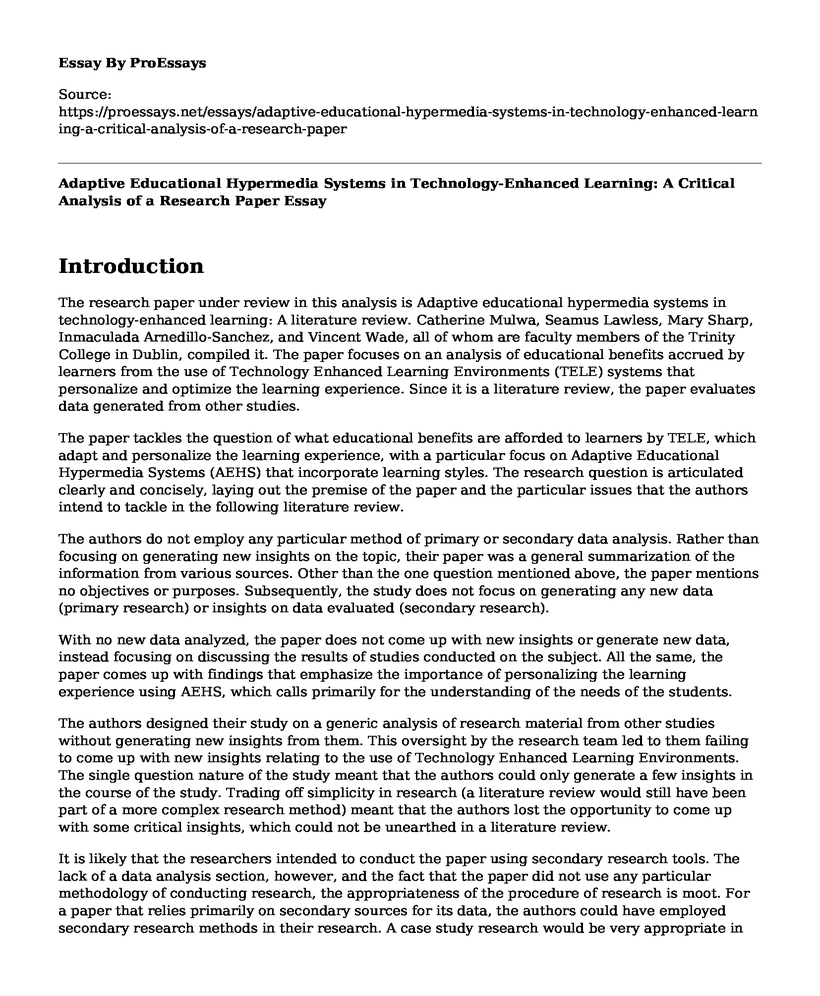Introduction
The research paper under review in this analysis is Adaptive educational hypermedia systems in technology-enhanced learning: A literature review. Catherine Mulwa, Seamus Lawless, Mary Sharp, Inmaculada Arnedillo-Sanchez, and Vincent Wade, all of whom are faculty members of the Trinity College in Dublin, compiled it. The paper focuses on an analysis of educational benefits accrued by learners from the use of Technology Enhanced Learning Environments (TELE) systems that personalize and optimize the learning experience. Since it is a literature review, the paper evaluates data generated from other studies.
The paper tackles the question of what educational benefits are afforded to learners by TELE, which adapt and personalize the learning experience, with a particular focus on Adaptive Educational Hypermedia Systems (AEHS) that incorporate learning styles. The research question is articulated clearly and concisely, laying out the premise of the paper and the particular issues that the authors intend to tackle in the following literature review.
The authors do not employ any particular method of primary or secondary data analysis. Rather than focusing on generating new insights on the topic, their paper was a general summarization of the information from various sources. Other than the one question mentioned above, the paper mentions no objectives or purposes. Subsequently, the study does not focus on generating any new data (primary research) or insights on data evaluated (secondary research).
With no new data analyzed, the paper does not come up with new insights or generate new data, instead focusing on discussing the results of studies conducted on the subject. All the same, the paper comes up with findings that emphasize the importance of personalizing the learning experience using AEHS, which calls primarily for the understanding of the needs of the students.
The authors designed their study on a generic analysis of research material from other studies without generating new insights from them. This oversight by the research team led to them failing to come up with new insights relating to the use of Technology Enhanced Learning Environments. The single question nature of the study meant that the authors could only generate a few insights in the course of the study. Trading off simplicity in research (a literature review would still have been part of a more complex research method) meant that the authors lost the opportunity to come up with some critical insights, which could not be unearthed in a literature review.
It is likely that the researchers intended to conduct the paper using secondary research tools. The lack of a data analysis section, however, and the fact that the paper did not use any particular methodology of conducting research, the appropriateness of the procedure of research is moot. For a paper that relies primarily on secondary sources for its data, the authors could have employed secondary research methods in their research. A case study research would be very appropriate in this case, as it would enable the researchers to generate new insights from previously compiled research data without having to conduct primary research activities such as interviews, experiments, etc.
The next step in the research started by Mulwa et al. (2010) should be to come up with actual new insights on the subject of Adaptive Educational Hypermedia Systems. A secondary assessment of strategic studies on the subject will generate the required data, employing qualitative data analysis tools in the scrutiny of data gathered. As the most effective methodology of secondary qualitative research methods, I would select three to five case studies to proceed with my research.
References
C. Mulwa, S. Lawless, Sharp, M., Arnedillo-Sanchez, I., & V. Wade. (2010). Adaptive educational hypermedia systems in technology enhanced learning: A literature review. Dublin: Trinity College
Cite this page
Adaptive Educational Hypermedia Systems in Technology-Enhanced Learning: A Critical Analysis of a Research Paper. (2022, May 02). Retrieved from https://proessays.net/essays/adaptive-educational-hypermedia-systems-in-technology-enhanced-learning-a-critical-analysis-of-a-research-paper
If you are the original author of this essay and no longer wish to have it published on the ProEssays website, please click below to request its removal:
- Technology and Young Children Learning Essay
- Annotated Bibliography: Parental Involvement and Academic Achievement
- Gagne's Nine Events of Instruction in Training Paper Example
- Art and Sensory Activities in Preschool Paper Example
- Four-Day School Weeks: Pros and Cons - Essay Sample
- Lawrence Kinlin School of Business: Health & Safety Critical Aspect - Essay Sample
- Paper Example on Descriptive Survey Design: A Cross-Sectional Snapshot







